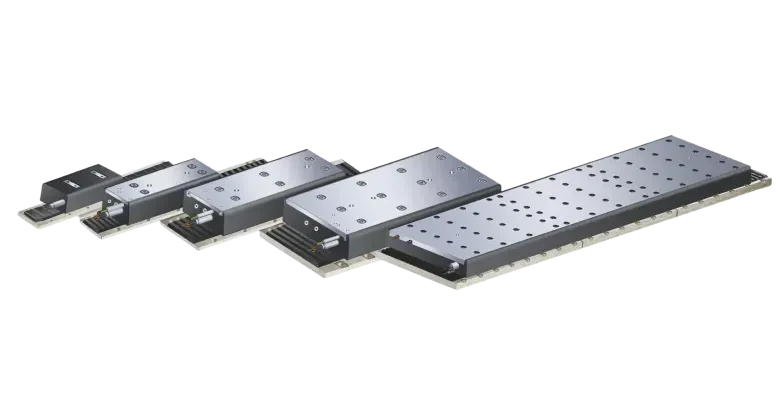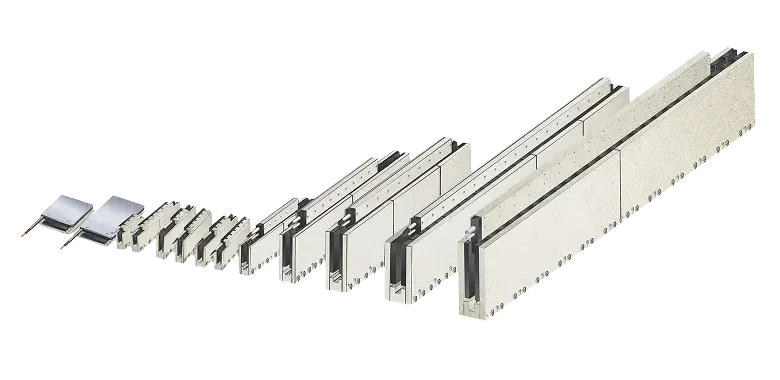In an era where speed, precision, and seamless automation are no longer optional but essential, linear motors are transforming the way machines move, literally. But how does a linear motor work beneath its sleek, silent performance?
Unlike conventional motors that spin, linear motors produce direct, straight-line motion without the need for gears, screws, or mechanical conversions. This unique capability not only reduces friction and wear but also unlocks new possibilities in high-performance applications across industries.
In this article, we’ll take you inside the engine of modern automation, exploring the core principles, components, and real-world operation of linear motors, and why they’re becoming indispensable in advanced engineering solutions.
What Is a Linear Motor?
A linear motor is an electric motor that generates motion in a straight line rather than rotational motion. Unlike traditional motors that rely on mechanical components to convert rotation into linear displacement, linear motors eliminate intermediate mechanisms, providing direct, precise, and high-speed movement.
If you’re wondering what is a linear motor, it’s essentially a rotary motor “unrolled” and laid flat, allowing the moving part (the forcer) to glide along a linear track powered by electromagnetic force.

4 Key Components of a Linear Motor
To fully grasp how does a linear motor work, it’s essential to understand the core components that enable its precise and frictionless motion. Although designs may vary across motor types, most linear motors share the following fundamental elements:
1. Stator (Primary Part)
The stator contains coils of wire through which electric current flows. This section generates the traveling magnetic field that drives the linear motion. In most configurations, the stator is the stationary part, mounted along the machine’s base.
2. Forcer or Slider (Secondary Part)
Also known as the moving part or armature, the forcer reacts to the magnetic field generated by the stator. It contains magnets or coils (depending on motor type) and moves linearly in response to electromagnetic forces. In some designs, the slider moves while the stator remains still; in others, it’s the opposite.
3. Linear Guide or Track
To ensure precise movement and mechanical support, a linear guide system is often used alongside the motor. This helps maintain alignment and reduces the risk of mechanical instability during high-speed motion.
4. Feedback System (Encoder)
High-performance linear motors typically integrate a linear encoder, a sensor that constantly monitors the position of the moving part. This feedback allows for closed-loop control, ensuring pinpoint accuracy, synchronization, and repeatability.
These components work in harmony to deliver smooth, direct motion without the need for traditional transmission elements like gears, belts, or screws. Together, they form the backbone of what makes linear motors a powerful solution in modern automation.
Understanding this fundamental concept is essential before diving deeper into how does a linear motor work, which we’ll explore in the next section.
The Core Principle Behind Linear Motor Operation
To understand how does a linear motor work, we need to look at the fundamental principle that drives it: electromagnetic force applied in a straight line. At its core, a linear motor operates on the same principle as a traditional rotary motor – Lorentz force – but instead of generating rotational torque, it creates direct linear thrust.
When current flows through the motor’s stator coils, it interacts with the magnetic field, producing a traveling magnetic wave. This wave propels the moving part (the forcer or slider) along a straight path.
Think of it as unfolding a rotary motor and laying it flat. The circular magnetic rotation becomes a linear magnetic wave that “pulls” or “pushes” the forcer along the axis. This conversion eliminates the need for screws, belts, or gears, reducing mechanical losses and enabling faster, more precise motion.
This elegant mechanism is what makes precision linear motors ideal for applications requiring high-speed, high-accuracy, and low-maintenance motion, qualities increasingly demanded in today’s automation-driven world.
How Does a Linear Motor Work?
Linear motors come in several different types, each designed to meet specific application requirements in terms of speed, force, precision, and structure. Understanding these variations is key to seeing how does a linear motor work across industries.
1. Iron-Core Linear Motors
These are among the most powerful and commonly used linear motor types in heavy-duty applications.
How they work: An iron-core linear motor consists of copper windings wrapped around laminated iron cores. When electrical current is applied, these windings interact with permanent magnets mounted on the track, producing strong electromagnetic force that propels the slider. The iron core acts as a magnetic conduit, amplifying thrust while maintaining compact size.

Advantages & Use Cases:
- High continuous and peak force capabilities
- Efficient thermal performance due to strong magnetic coupling
- Ideal for CNC machines, plastic injection systems, and automation lines where brute force and durability matter
- Downsides include potential cogging and higher mass, which can affect motion smoothness
This type is a textbook case of how does a linear motor work when power and force take priority.
2. Ironless (Air-Core) Linear Motors
Designed for finesse and speed, ironless motors deliver motion with virtually zero friction or ripple.
How they work: Unlike iron-core variants, air-core linear motors have no ferromagnetic material in the moving part. Instead, coils are suspended between two magnet tracks, “floating” in a magnetic field. As current flows through the coils, the resulting force drives the slider without any cogging or magnetic pull.

Advantages & Use Cases:
- Exceptionally smooth and precise motion
- Low moving mass enables rapid acceleration and deceleration
- Extremely low heat generation and electromagnetic interference
- Common in cleanroom environments such as semiconductor fabs, medical devices, and optical inspection systems
These motors are the best demonstration of how does a linear motor work when micro-precision and responsiveness are top priorities.
3. Tubular Linear Motors
When compactness meets symmetry, tubular linear motors offer the best of both worlds.
How they work: Tubular motors feature a cylindrical design with a rod containing permanent magnets (the thrust rod) inside a coil assembly. When energized, the coils generate a magnetic field that pushes or pulls the rod in a straight line. The round geometry enables uniform force application in all directions, reducing side loads and improving mechanical balance.
Advantages & Use Cases:
- Space-saving design with high force density
- Ideal for pushing/pulling actions in tight spaces
- Used in robotics, vertical actuators, medical pumps, and fast packaging systems
Their simplicity and efficiency offer a compact and elegant answer to the question, how does a linear motor work in space-constrained environments.
4. Ironless Vacuum Linear Motors
Engineered for ultra-clean environments, Ironless Vacuum Linear Motors bring cutting-edge performance to semiconductor and high-vacuum applications.
How they work: Similar in principle to standard ironless motors, these vacuum-compatible models are specially designed for ultra-high vacuum (UHV) or clean environments. The motor components are manufactured using vacuum-rated materials and processes that minimize outgassing, while still providing frictionless and cog-free linear motion.
Where they shine:
- Semiconductor wafer handling systems
- Vacuum chambers and particle accelerators
- Flat panel display manufacturing and high-end inspection equipment
By combining high-speed precision with contamination-free operation, this motor is a premium demonstration of how does a linear motor work in the most demanding, sterile conditions. As part of ITG’s expanding product lineup, it highlights our commitment to future-forward motion solutions.
Real-World Examples: How Linear Motors Work in Applications
Understanding how does a linear motor work becomes even clearer when we look at how these systems power real-world technologies across industries. From manufacturing lines to medical robots, linear motors play a critical role in delivering precise, fast, and reliable motion. Here are a few standout examples:
1. Semiconductor Manufacturing
In chip fabrication, even the smallest vibration can ruin a microscopic circuit. That’s why ironless linear motors, known for their ultra-smooth, cog-free motion, are widely used in wafer steppers and lithography machines.
How does a linear motor work here? The motor enables nanometer-level positioning of silicon wafers by translating electrical energy directly into smooth motion, without needing mechanical transmission components. This reduces particle generation and ensures cleanroom compatibility.
2. High-Speed Packaging Lines
In consumer goods packaging, speed and synchronization are everything. Linear motors allow packaging heads, cutters, or pick-and-place systems to move rapidly and independently along a production line.
It moves actuators along a magnetic track with near-zero lag time, adjusting speeds dynamically in real time. This flexibility increases throughput while maintaining product alignment and accuracy.
3. MRI and Medical Imaging Systems
Medical equipment often requires precise, quiet, and vibration-free motion, particularly when scanning sensitive parts of the body.
How does a linear motor work in MRI scanners? It provides smooth, controlled movement of imaging tables and gantries, reducing noise and improving patient comfort. The absence of mechanical gears or belts eliminates maintenance and contamination risks.
4. Automated Inspection and Metrology
In quality control systems, camera or sensor heads must move quickly and consistently across parts being inspected.
By using feedback-controlled linear motors, inspection systems can reposition with micron-level repeatability – ideal for industries such as electronics, aerospace, and precision optics.
5. Vacuum & Cleanroom Applications (ITG Ironless Vacuum Motors)
In high-vacuum environments like particle accelerators or OLED fabrication lines, contamination-free motion is critical. ITG’s Ironless Vacuum Linear Motors are specifically built for this.
Vacuum-rated materials and a sealed, ironless design ensure that no particles are released during motion. The result: precise, long-term motion in sensitive environments – without mechanical degradation.
These real-world cases clearly illustrate how does a linear motor work across a spectrum of high-performance applications. Whether it’s speed, precision, or cleanliness, linear motors have become a cornerstone of modern engineering and automation.
Why ITG Is Your Trusted Partner in Linear Motor Solutions
Choosing the right partner for your linear motion systems can define the success of your automation strategy. At ITG, we go beyond simply supplying motors – we deliver precision-driven solutions designed for demanding, high-performance environments.
- Cutting-Edge Product Portfolio: ITG offers a comprehensive range of linear motor technologies, including iron-core, ironless, and the newly launched Ironless Vacuum Linear Motor. This latest addition is specifically engineered for ultra-clean, high-vacuum environments, making it ideal for advanced semiconductor, medical, and precision automation applications.
- Tailored Engineering Solutions: We understand that every application has its own challenges. That’s why ITG provides customized engineering services and application-specific motor designs. Our team works closely with your engineers to co-create solutions that ensure compatibility, efficiency, and long-term performance.
- Built for Reliability and PrecisionI: ITG motors are developed with meticulous attention to quality and performance. Designed for continuous operation and micrometer-level accuracy, our linear motors are trusted in industries where precision, speed, and reliability are non-negotiable.
- Global Reach, Local Support: With a strong foundation in engineering excellence and a growing global presence, ITG combines innovation with accessibility. From pre-sales consultation to after-sales technical support, our team is committed to helping customers optimize performance at every stage.
- Investing in the Future of Motion: Innovation is at the core of everything we do. ITG continues to invest in R&D to pioneer smarter, more efficient linear motor technologies. We’re not only responding to the demands of modern automation, we’re helping shape its future.
When it comes to linear motor expertise and innovation, ITG is the partner you can trust. Let us help you turn precision motion into competitive advantage.
Conclusion
In summary, understanding how does a linear motor work is key to unlocking its full potential across a wide range of industries. From precise positioning in semiconductor manufacturing to contamination-free operation in vacuum environments, linear motors offer unmatched performance and reliability.
With ITG’s advanced technologies and tailored solutions, you can confidently harness the power of linear motors to drive innovation and efficiency in your applications. Choose ITG as your trusted partner and experience the difference that cutting-edge linear motor expertise can make.

